| |
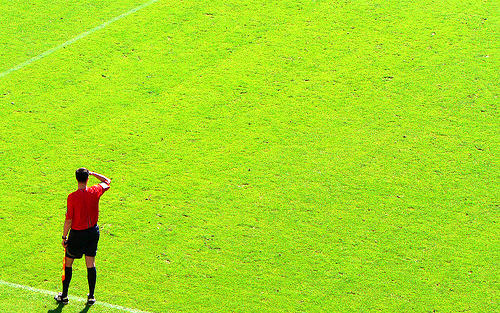 |
FREE KICK RESTARTS & DROPPED BALL RESTARTS
The… Differences!!!
Andrew Castiglione
Founder of Ken Aston Referee Society
 |
"This page contains a simple structured method of dealing with Free Kick Restarts
&
Dropped Ball Restarts and the Differences on the field of play."
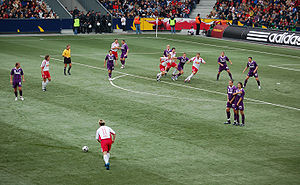 |
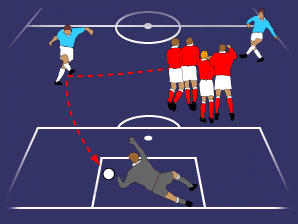 |
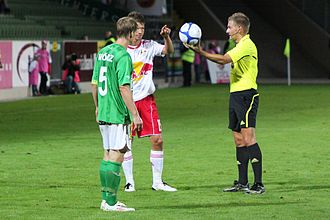 |
When play needs to be stopped, one of the most
difficult aspects for new Referees to understand, is
appreciating the differences between the three restarts:
Direct Free Kick (Laws 12 & 13), Indirect Free
Kick (Laws 12 & 13), and the Dropped Ball
(Law 8).
The details shown below cover all the restart instances
mentioned in the Laws and more. This detail will be particularly
useful, both as a ‘study aid’ for new candidates preparing for
their Referee exam; and as a reminder to existing Referees. |
Section A: Differences Between
a Direct Free Kick, Indirect Free Kick and a Dropped Ball:
Section B: Direct Free Kick
Offences.
Section C: Indirect Free Kick
Offences.
Section D: Dropped Ball
Restarts.
Section E: Special
Circumstances Law 8
Section A. Differences Between a
Direct Free Kick,Indirect Free Kick and a Dropped Ball:
It can sometimes be difficult for new trainee Referees to differentiate
between a ‘Direct Free Kick’ restart, an ‘Indirect Free Kick’ restart,
or a 'Dropped Ball’ restart.
A Direct Free Kick, an Indirect Free Kick or a Dropped Ball can only be
awarded if the Referee needs to stop play whilst the ball is on the
field of play.
Direct Free Kick:
There is ONLY 10 Direct Free kick offences. The ball must be on the
field of play, and the offence must be committed whilst play is in
progress. The offence must be committed against the opposing team. A
Direct Free Kick cannot be awarded for offences committed between
players of the same team. Or for offences committed off the field of
play. Or for offences committed by players against the Referee or team
officials or spectators etc.
A Direct Free Kick restart cannot be awarded for offences
committed whilst the ball is OUT of play.
Dropped Ball: A
dropped ball is used to restart play, when the Referee under the
following circumstances has stopped play:
Due to external interference (such as a dog entering the field of play)
If a serious injury is suspected
After a temporary stoppage that becomes necessary while the ball is in
play - for any reason not mentioned elsewhere in the Laws of the Game
(such as a player losing his shorts!!)
For any other reason which is not covered by Direct and Indirect
Free-kicks.
A dropped ball restart cannot be awarded for offences
committed whilst the ball is OUT of play.
Indirect Free Kick:
There are hundreds of reasons to restart play with an Indirect Free
Kick. Basically, if the stoppage in play is for a foul or an offence
that does not merit the award of a Direct Free-Kick, then an Indirect
Free Kick is the usual restart.
Please note, that on all the Direct Free Kick, Dropped Ball and Indirect
Free Kick restarts, the ball must have been in play when the Referee
stops play.
A Free Kick (Direct or Indirect) or a dropped ball restart cannot be
awarded for offences committed whilst the ball is OUT of play.
If an offence occurs before the ball has come back into play during the
taking of a goal kick or a throw–in, play is restarted with either the
original goal kick or the original throw-in.
Section B: Direct Free Kick
Offences
(Or Penalty kick if committed against an opponent by a defender in his
own penalty area.)
(To be taken at the place where the incident occurred unless stated
otherwise.)
(There are only 10 Direct Free Kick Offences.)
 - 1. Kicks or attempts to kick an opponent; - careless,
reckless or using excessive force. (Law 12)
- 1. Kicks or attempts to kick an opponent; - careless,
reckless or using excessive force. (Law 12)
 - 2. Trips or attempts to trip an opponent; careless, reckless
or using excessive force. (Law 12)
- 2. Trips or attempts to trip an opponent; careless, reckless
or using excessive force. (Law 12)
 - 3. Jumps at an opponent; careless, reckless or using
excessive force. (Law 12)
- 3. Jumps at an opponent; careless, reckless or using
excessive force. (Law 12)
 - 4. Charges an opponent; careless, reckless or using excessive
force. (Law 12)
- 4. Charges an opponent; careless, reckless or using excessive
force. (Law 12)
 - 5. Strikes or attempts to strike an opponent; careless,
reckless or using excessive force. (Law 12)
- 5. Strikes or attempts to strike an opponent; careless,
reckless or using excessive force. (Law 12)
 - 6. Pushes an opponent; careless, reckless or using excessive
force. (Law 12)
- 6. Pushes an opponent; careless, reckless or using excessive
force. (Law 12)
 - 7. Tackles an opponent to gain possession of the ball, making contact
with the opponent before touching the ball. (Law 12)
- 7. Tackles an opponent to gain possession of the ball, making contact
with the opponent before touching the ball. (Law 12)
 - 8. Holds an opponent. (Law 12)
- 8. Holds an opponent. (Law 12)
 - 9. Spits at an opponent. (Law 12)
- 9. Spits at an opponent. (Law 12)
 - 10. Handles the ball deliberately * (except for the
goalkeeper within his own penalty area). (Law 12)
- 10. Handles the ball deliberately * (except for the
goalkeeper within his own penalty area). (Law 12)
*Handling examples
follow:
 - A ‘Direct Free Kick’ is awarded if a goalkeeper deliberately
handles the ball outside of his penalty area.
- A ‘Direct Free Kick’ is awarded if a goalkeeper deliberately
handles the ball outside of his penalty area.
 - If after the ball is in play, a goalkeeper who is taking a
throw-in, deliberately handles the ball outside of his own penalty area
before it has touched another player - a ‘Direct Free Kick’ is awarded.
- If after the ball is in play, a goalkeeper who is taking a
throw-in, deliberately handles the ball outside of his own penalty area
before it has touched another player - a ‘Direct Free Kick’ is awarded.
 - If after the ball is in play, a player taking a throw-in
deliberately handles the ball before it has touched another player - a
‘Direct Free Kick’ is awarded (or a penalty kick if the incident occurs
inside the player’s own penalty area.)
- If after the ball is in play, a player taking a throw-in
deliberately handles the ball before it has touched another player - a
‘Direct Free Kick’ is awarded (or a penalty kick if the incident occurs
inside the player’s own penalty area.)
 - If, after the ball is in play, a player taking a goal kick
deliberately handles the ball before it has touched another player - a
‘Direct Free Kick’ is awarded.
- If, after the ball is in play, a player taking a goal kick
deliberately handles the ball before it has touched another player - a
‘Direct Free Kick’ is awarded.
(Note – during the taking of a goal kick, the ball must travel
wholly outside of the penalty are before it is deemed to be in play.)
(Note – a penalty kick is awarded if a player (not the goalkeeper)
taking a goal kick deliberately handles the ball inside his own penalty
area. For this to happen, the player taking the goal kick, would have to
kick the ball outside of his penalty area for it to become ‘in play’.
The ball would then have to return (wind assisted) without being touched
by another player, back into the penalty area before being handled by
the infringing player.)
 - If a goalkeeper takes a corner kick, and after the ball is in
play, he deliberately handles the ball outside of his own penalty area
before it has touched another player - a ‘Direct Free Kick’ is awarded.
- If a goalkeeper takes a corner kick, and after the ball is in
play, he deliberately handles the ball outside of his own penalty area
before it has touched another player - a ‘Direct Free Kick’ is awarded.
 - If after the ball is in play, a player taking a corner kick
deliberately handles the ball before it has touched another player - a
‘Direct Free Kick’ is awarded.
- If after the ball is in play, a player taking a corner kick
deliberately handles the ball before it has touched another player - a
‘Direct Free Kick’ is awarded.
(Note – a penalty kick is awarded if a player (not the goalkeeper)
taking a corner kick deliberately handles the ball inside his own
penalty area before another player has touched it. For this to happen,
the player taking the corner kick, would have to kick the ball all the
way back into his own penalty area, and deliberately handle it inside
his own penalty area before it had been touched by another player. This
scenario in very unlikely to ever occur!)
 - If a player taking a penalty kick deliberately handles the
ball before it has touched another player - a ‘Direct Free Kick’ is
awarded to the defending team.
- If a player taking a penalty kick deliberately handles the
ball before it has touched another player - a ‘Direct Free Kick’ is
awarded to the defending team.
Section C: Indirect Free Kick Offences
(Normally, to be taken at the place where the incident occurred
unless stated otherwise.)
(Below are listed the common Indirect Free Kick offences - there are
many more. The easiest way to remember these, is to understand that if
it is not one of the 10 Direct Free Kick offences mentioned above (or a
‘Dropped Ball restart), the restart is an Indirect Free Kick).
If a goalkeeper, inside his own penalty area, commits any of
the following four offences:
 - 1. Takes more than six seconds while controlling the ball
with his hands before releasing it from his possession. (Law 12)
- 1. Takes more than six seconds while controlling the ball
with his hands before releasing it from his possession. (Law 12)
 - 2. Touches the ball again with his hands after it has been
released from his possession and has not touched any other player. (Law
12)
- 2. Touches the ball again with his hands after it has been
released from his possession and has not touched any other player. (Law
12)
 - 3. Touches the ball with his hands after it has been
deliberately kicked to him by a team-mate. (Law 12) (Sometimes
referred to as a ‘Back-Pass)
- 3. Touches the ball with his hands after it has been
deliberately kicked to him by a team-mate. (Law 12) (Sometimes
referred to as a ‘Back-Pass)
 - 4. Touches the ball with his hands after he has received it
directly from a throw-in taken by a team-mate. (Law 12)
- 4. Touches the ball with his hands after he has received it
directly from a throw-in taken by a team-mate. (Law 12)
An indirect free kick is also awarded to the opposing team
if a player, in the opinion of the Referee commits the following four
offences:
 - 5. Plays in a dangerous manner. (Law 12)
- 5. Plays in a dangerous manner. (Law 12)
 - 6. Impedes the progress of an opponent. (Law 12)
(Sometimes referred to as Obstruction.)
- 6. Impedes the progress of an opponent. (Law 12)
(Sometimes referred to as Obstruction.)
 - 7. Prevents the goalkeeper from releasing the ball from his
hands. (Law 12)
- 7. Prevents the goalkeeper from releasing the ball from his
hands. (Law 12)
 - 8. Commits any other offence, not previously mentioned in Law
12, for which play is stopped to caution or dismiss a player. (Law 12)
- 8. Commits any other offence, not previously mentioned in Law
12, for which play is stopped to caution or dismiss a player. (Law 12)
(For example, when the Referee stops play to administer a caution
for dissent.)
Law 3 – The Number of Players:
If play is stopped by the Referee to administer a caution, the match is
restarted by an indirect free kick, to be taken by a player of the
opposing team from the place where the ball was when play was stopped.
Examples:
 - 9. A bleeding player refuses to leave the field of play when
asked to do so by the Referee.
- 9. A bleeding player refuses to leave the field of play when
asked to do so by the Referee.
(Law 3)
 - 10. After starting the second half, the Referee notices that
one team has 12 players. (Law 3)
- 10. After starting the second half, the Referee notices that
one team has 12 players. (Law 3)
Note: If a substitute enters the field of play without
the Referee’s permission, if the Referee stops the game, play is
restarted with a dropped ball at the place it was located when play was
stopped. (Law 3).
Law 4 – The Players Equipment:
If play is stopped by the Referee to administer a caution, the match is
restarted by an indirect free kick, to be taken by a player of the
opposing team from the place where the ball was when play was stopped.
Examples:
 - 11. A player refuses to tie up his bootlaces. (Law 4)
- 11. A player refuses to tie up his bootlaces. (Law 4)
 - 12. A player refuses to take off a necklace or an earring.
(Law 4)
- 12. A player refuses to take off a necklace or an earring.
(Law 4)
Law 8 – The Start and Restart of Play
If when the ball is in play, the kicker touches the ball a second time
(except with his hands) before it has touched another player, an
indirect free kick is awarded to the opposing team, the indirect free
kick to be taken from the place where the infringement occurred.
Example:
 - 13. A player taking a kick-off, touches the ball a second
time (except with his hands) before it has been touched by another
player. (Law 8)
- 13. A player taking a kick-off, touches the ball a second
time (except with his hands) before it has been touched by another
player. (Law 8)
For any other infringement of the kick-off procedure - the kick-off is
retaken.
Law 12 – Fouls and Misconduct: (additional examples)
 - 14. Circumventing the Laws to gain possession of the ball.
For example, when a player flicks the ball up with his foot, and then
heads it to his goalkeeper. (Law 12 International Decision 3.)
- 14. Circumventing the Laws to gain possession of the ball.
For example, when a player flicks the ball up with his foot, and then
heads it to his goalkeeper. (Law 12 International Decision 3.)
 - 15. A player strikes the Referee. (Law 12 Violent Conduct.)
- 15. A player strikes the Referee. (Law 12 Violent Conduct.)
 - 16. A player strikes a colleague. (Law 12 Violent Conduct.)
- 16. A player strikes a colleague. (Law 12 Violent Conduct.)
 - 17. Referee stops play to administer a caution for dissent.
(Law 12 Shows Dissent.)
- 17. Referee stops play to administer a caution for dissent.
(Law 12 Shows Dissent.)
 - 18. A player uses offensive, or insulting, or abusive
language and/or gestures towards any player, a manger, the Referee or
anyone else. (Law 12 Sending Off Offence.)
- 18. A player uses offensive, or insulting, or abusive
language and/or gestures towards any player, a manger, the Referee or
anyone else. (Law 12 Sending Off Offence.)
 - 19. Enters or re-enters the field of play without the
Referee's permission. (Law 12 Cautionable Offence) (If game stopped to
administer a caution, Indirect free kick to be taken by a player of the
opposing team from the place where the ball was when play was stopped.)
- 19. Enters or re-enters the field of play without the
Referee's permission. (Law 12 Cautionable Offence) (If game stopped to
administer a caution, Indirect free kick to be taken by a player of the
opposing team from the place where the ball was when play was stopped.)
 - 20. Deliberately leaves the field of play without the
referee's permission. Law 12 Cautionable Offence) (The indirect free
kick would have to be taken at the point on the boundary line where the
player left the field of play – where the offence actually took place.)
- 20. Deliberately leaves the field of play without the
referee's permission. Law 12 Cautionable Offence) (The indirect free
kick would have to be taken at the point on the boundary line where the
player left the field of play – where the offence actually took place.)
 - 21. Shouting, "Leave it" when trying to deceive an opponent.
(Law 12 Cautionable Offence Unsporting behavior.)
- 21. Shouting, "Leave it" when trying to deceive an opponent.
(Law 12 Cautionable Offence Unsporting behavior.)
 - 22. Using a colleague's back to gain height when heading the
ball. (Law 12 Cautionable Offence Unsporting behavior.)
- 22. Using a colleague's back to gain height when heading the
ball. (Law 12 Cautionable Offence Unsporting behavior.)
Law 13 – Free Kicks:
 - 23. A player taking a free kick, touches the ball a second
time before it has been touched by another player. (Law 13)
- 23. A player taking a free kick, touches the ball a second
time before it has been touched by another player. (Law 13)
(Note: A free kick taken by the defending team within its own penalty
area must travel outside of the penalty area before it is deemed, to be
'in-play'. If the ball is touched a second time before it has traveled
outside of the penalty area, the free kick should be retaken. (Law 13)
Law 14 – The Penalty Kick:
 - 24. If a team-mate of the player taking the kick enters the
penalty area or moves in front of or within 9.5 m (10 yards) of the
penalty mark and if the ball rebounds from the goalkeeper, the crossbar
or the goal post and is touched by this encroaching player. (Law 14)
- 24. If a team-mate of the player taking the kick enters the
penalty area or moves in front of or within 9.5 m (10 yards) of the
penalty mark and if the ball rebounds from the goalkeeper, the crossbar
or the goal post and is touched by this encroaching player. (Law 14)
 - 25. If after the penalty kick has been taken, the kicker
touches the ball a second time (except with his hands) before it has
touched another player. (Law 14)
- 25. If after the penalty kick has been taken, the kicker
touches the ball a second time (except with his hands) before it has
touched another player. (Law 14)
Law 15 – The Throw-In:
Throw-in taken by other than the goalkeeper.
 - 26. If after the ball is in play, the thrower touches the
ball a second time (except with his hands) before it has touched another
player. (Law 15)
- 26. If after the ball is in play, the thrower touches the
ball a second time (except with his hands) before it has touched another
player. (Law 15)
Throw-in taken by the goalkeeper.
 - 27. If, after the ball is in play, the goalkeeper touches the
ball a second time (except with his hands) before it has touched another
player. (Law 15)
- 27. If, after the ball is in play, the goalkeeper touches the
ball a second time (except with his hands) before it has touched another
player. (Law 15)
 - 28. If, after the ball is in play, the goalkeeper
deliberately handles the ball inside his own penalty area before it has
touched another player. (Law 15)
- 28. If, after the ball is in play, the goalkeeper
deliberately handles the ball inside his own penalty area before it has
touched another player. (Law 15)
Law 16 – The Goal Kick:
Goal kick taken by a player other than the goalkeeper:
 - 29. If, after the ball is in play, the kicker touches the
ball a second time (except with his hands) before it has touched another
player. (Law 16)
- 29. If, after the ball is in play, the kicker touches the
ball a second time (except with his hands) before it has touched another
player. (Law 16)
Goal kick taken by the goalkeeper:
 - 30. If, after the ball is in play, the goalkeeper
deliberately handles the ball inside his own penalty area before it has
touched another player. (Law 16)
- 30. If, after the ball is in play, the goalkeeper
deliberately handles the ball inside his own penalty area before it has
touched another player. (Law 16)
(For this to happen, the goalkeeper would have to kick the ball
outside of his penalty area for it to become ‘in play’. The ball would
then have to return (wind assisted) without being touched by another
player, back into the penalty area before being handled by the
infringing goalkeeper.)
Law 17 – The Corner Kick:
 - 31. If after the ball is in play, a player taking a corner
kick touches the ball a second time (except with his hands) before it
has touched another player. (Law 17)
- 31. If after the ball is in play, a player taking a corner
kick touches the ball a second time (except with his hands) before it
has touched another player. (Law 17)
 - 32. A goalkeeper takes a corner kick, and after the ball is
in play, he deliberately handles the ball inside of his own penalty area
before it has touched another player. (Law 17)
- 32. A goalkeeper takes a corner kick, and after the ball is
in play, he deliberately handles the ball inside of his own penalty area
before it has touched another player. (Law 17)
(Note – For this to happen, the goalkeeper taking the corner kick,
would have to kick the ball all the way back into his own penalty area,
and deliberately handle it inside his own penalty area before it had
been touched by another player. This scenario in very unlikely to ever
occur!)
Section D: Dropped Ball Restarts
(To be taken normally at the place where the ball was located when play
was stopped.)
(Exception - A dropped ball to re-start the match after play has been
stopped inside the goal area, takes place on the goal area line parallel
to the goal line at the point nearest to where the ball was located when
play was stopped.)
Note: The examples shown below that are annotated with the Law Number,
are actual references within the Laws. And therefore, questions
concerning these are more likely to be asked in a Referee exam.
 -
1. If a crossbar becomes displaced or broken. (Law 1)
-
1. If a crossbar becomes displaced or broken. (Law 1)
 -
2. If the ball bursts or becomes defective during the course of a match.
(Law 2)
-
2. If the ball bursts or becomes defective during the course of a match.
(Law 2)
 -
3. If a substitute enters the field of play without the Referee being
informed. (Law 3)
-
3. If a substitute enters the field of play without the Referee being
informed. (Law 3)
 -
4. If a serious injuries occurs. (Law 5)
-
4. If a serious injuries occurs. (Law 5)
 -
5. If head injuries occur. (Law 5)
-
5. If head injuries occur. (Law 5)
 -
6. Outside (external) interference. Examples: Dog, crowd, or manager on
the field of play. (Law 5)
-
6. Outside (external) interference. Examples: Dog, crowd, or manager on
the field of play. (Law 5)
 -
7. Improper conduct by an Assistant Referee or Club Linesman. (Law 6)
-
7. Improper conduct by an Assistant Referee or Club Linesman. (Law 6)
 -
8. After a temporary stoppage that becomes necessary while the ball is
in play - for any reason not mentioned elsewhere in the Laws of the Game
(such as a player losing his shorts!!) (Law 8)
-
8. After a temporary stoppage that becomes necessary while the ball is
in play - for any reason not mentioned elsewhere in the Laws of the Game
(such as a player losing his shorts!!) (Law 8)
Some further dropped ball examples:
 -
9. Ball deflected by an overhanging tree branch.
-
9. Ball deflected by an overhanging tree branch.
 -
10. A dropped ball may sometimes be used to start a charity match where
both of the teams are not really competing against each other.
-
10. A dropped ball may sometimes be used to start a charity match where
both of the teams are not really competing against each other.
 -
11. Dropped ball can be used instead of a kick-off in some 6-a-side
competitions etc.
-
11. Dropped ball can be used instead of a kick-off in some 6-a-side
competitions etc.
 -
12. An offence committed by a player outside of the field of play whilst
the ball was in play.
-
12. An offence committed by a player outside of the field of play whilst
the ball was in play.
 -
13. A substitute sitting in the technical area throws an object at an
opponent who is on the field of play.
-
13. A substitute sitting in the technical area throws an object at an
opponent who is on the field of play.
 -
14. Dangerous item found on the field of play.
-
14. Dangerous item found on the field of play.
Section E: Special Circumstances Law 8
A free kick awarded to the defending team inside its own
goal area can be taken from any point within the goal area.
An indirect free kick awarded to the attacking team in its
opponents' goal area is taken from the goal area line parallel
to the goal line at the point nearest to where the infringement
occurred.
A dropped ball to restart the match after play has been
temporarily stopped inside the goal area, takes place on the
goal area line parallel to the goal line at the point nearest to
where the ball was located when play was stopped. |
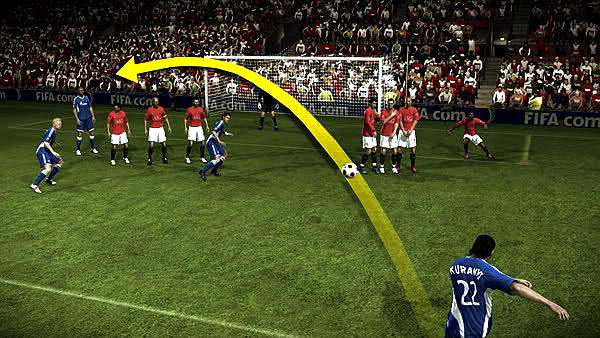 |
|